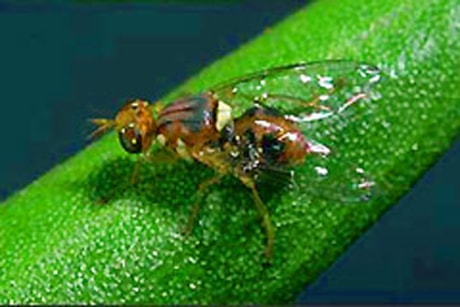The Big Stink in the Big Smoke has left homeowners grappling with a tiny, pesky problem.
Much of Canada’s largest city is in the grip of a fruit fly infestation, the result in part of the six-week city workers strike that gave rise to mountains of rotting trash in temporary dump sites throughout the metropolis.
Those piles of green garbage bags, redolent with the odour of decomposing fruits and vegetables as they cooked in the summer heat, would have proved an irresistible lure to genus Drosophila and provided the tiny insects with a perfect breeding ground, said Gard Otis, an entomologist at Ontario’s University of Guelph.
“You’ve got all the conditions for producing a lot of fruit flies,” he said of Toronto residents’ battle with the bug. “So it doesn’t surprise me at all. It seems quite logical.”
Clouds of the vexing critters have infiltrated many homes seeking out ripening bananas, peaches and other kitchen counter-residing products of Nature’s summertime bounty, where they lay their eggs to start the next generation.
The red-eyed fruit flies, also known as vinegar flies, are drawn to gases like acetic acid (vinegar) and ethanol emitted by ripening fruits and vegetables.
Females deposit their eggs in cracks or broken skin of the produce. The eggs hatch into larvae (maggots), which feast on yeast products inside the produce. When they emerge as adult flies about 10 days later, the insects become sexually active in about two days and the cycle begins again.
Females can lay about 500 eggs in their roughly two-week-long lifespan.
“So we’ve got three generations of flies with a lot of food,” Otis said of the garbage-strike period. “And people really can’t conceive of when you have that many babies being produced, that have the capacity to produce so many babies, how fast they can generate numbers.”
Fed up with swatting legions of the annoying fly-in-your-face creatures, many Torontonians have been scurrying to buy traps from hardware and other stores, only to find the gizmos have been sold out in many locales.
Peter Riley, an employee of Lee Valley Tools in downtown Toronto, said there’s been a noticeable increase this summer in the number of customers looking for traps.
“We have the fruit-fly traps every year and we do sell a good amount of them,” he said. “But it seems more this year for sure, and more people on a daily basis are asking for them.”
“We ran out of stock for a week or so, last week. It was just after the garbage strike.”
Still, it seems not all garbage strikes leave behind the winged gift that keeps on giving. Residents of Windsor, Ont., which endured a 101-day loss of trash pickup that ended July 25, don’t seem to have the same problem with an out-of-the-ordinary proliferation of fruit flies invading homes, restaurants and grocery stores.
“We are not getting calls for fruit flies — very, very few,” said a spokeswoman for Windsor Pest Control.
That may be the case for elsewhere in the country, too. Even in Summerland, B.C., one of Canada’s most prolific fruit-growing regions, this year seems no different than any other average year for the bitty beasties.
“We have got little tiny fruit flies that you have in houses hanging around bananas and so on, which I gather are a real issue in Toronto right now,” said Howard Thistlewood, a research scientist for Agriculture and Agri-Food Canada in Summerland. “We’ll always have those coming up seasonally because we have so much fruit in the Okanagan.”
“If you harvest the fruit and bring it home ... you’ll have some. But that is not worse than any other year, definitely. It’s just a normal year.”
So what should people do to beat the bugs?
“There are some nice compact, little baits that are sold by some natural insect control stores, which contain acetic acid, or vinegar,” said entomologist Rebecca Hallett of the University of Guelph, who specializes in pest management.
The traps have tiny perforations in the top, and once the fruit flies crawl inside, they can’t get out again and die, she said. “And you can just set it on your counter or even in your bowl of fruit and the fruit flies would go into there.”
Homeowners can also fashion their own traps by putting a banana or peach in a jar, stretching plastic wrap over the top, then poking several holes in it about the size of ballpoint pen tip. Vinegar, wine and even fruit juice in a similarly covered jar will also act as magnets for the insects.
Experts also advise regular disinfection of counter tops, throwing out overripe fruit and frequent emptying of kitchen garbage containers.
While fruit flies have been implicated in the possible spread of plant diseases, Hallett said they aren’t known to have any adverse effects on human health.
“If there’s a slight bruise, it’s possible you may consume an egg or minuscule larvae of a fruit fly at the same time as eating that bruise,” she said. “But all it’s going to give you is a bit of extra protein.”
